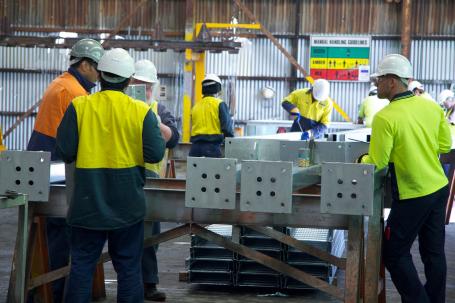Cleaning of Galvanised Surfaces
There are a number of ways of treating different types of stains or marks. It is advised that any of the cleaning treatments used on galvanized steel should be conservative at first and then, if the situation demands, the treatment become steadily more aggressive. It is also important and recommended that wherever some form of mechanical abrasion or “scrubbing” is required, a hard plastic bristle brush be used. Steel bristle brushes are not to be used since they will cause discolouration of the galvanising.
It is important to note that mechanical methods of cleaning zinc surfaces can cause aesthetic issues. The “cleaned” areas are likely to contrast with adjacent untreated surfaces and may take a significant period of time to weather to a uniform colour. If aesthetics is a large concern, it is advisable to first test the cleaning method in an inconspicuous area in case the aesthetic effect is unappealing.
For general cleaning of bulk contaminants, such as dirt and the like, ordinary laundry soaps can be satisfactorily used. For more stubborn or larger areas, the use of a low pressure wash (such as a gurney gun), with solely pure water or in conjunction with proprietary cleaning materials, such as car wash or truck wash, can be effective. The car and truck cleaners are made to minimise corrosion on the metallic parts of vehicles so are generally suitable for use on galvanized steel although it is important that the steel be washed down with freshwater after cleaning.
Many mild stains (such as those from water ponding and water runs or, in public areas, those from beverages such as beer, wine etc.) can be removed with the use of common household ammonia cleansers, again being sure to thoroughly rinse the galvanized article with freshwater afterwards.
Often, water draining from other adjacent steelwork that is rusting can flow on to galvanized steel and cause conspicuous brown staining. This can be treated with the use of commercial oxalic acid or a proprietary solution that has been developed for descaling pots and pans. Thorough rinsing with water is again important to remove any corrosive residues of the cleaner.
Sometimes during building or renovations, cement and mortar can be dropped onto the galvanized steel and this can be very difficult to remove once it has hardened. Firstly remove the large parts of the deposit as close to the surface as practical, then oxalic acid can be used to remove the remaining remnants from the galvanized steel, followed with a thorough rinsing.
Other acids are more effective on the mortar or cement, but these can be very aggressive on zinc and are not recommended.
Paints, such as graffiti, can be removed using thinners. If some form of scraping is required, use plastic or wooden scrapers (not steel/metallic items). If the paint is wet or fresh, then normal thinners can be used. Once the paint has hardened, then a non-alkaline stripper can be used. Again, rinsing is important to remove residues that may cause discolouration later and/or encourage corrosion.
Material supplied by the GAA.

